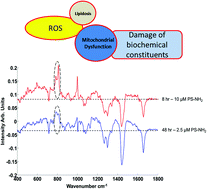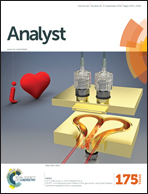In vitro monitoring of time and dose dependent cytotoxicity of aminated nanoparticles using Raman spectroscopy†
Abstract
Investigation of possible adverse health effects of nanomaterials, in a rapid multi-parametric fashion, has become increasingly important, due to their increased production and potential uses in a wide range of application areas, from cosmetics to pharmaceutics. Although conventional in vitro cytotoxicological techniques provide valuable information about the particle toxicity, the importance of gaining high content information in a single assay with the analysis of multiple parameters in a non-invasive and label-free way is still one of the biggest challenges in nanotoxicology. As a vibrational spectroscopic technique, the power of Raman spectroscopy for the analysis of cells, tissues and also nanoparticle localization within cells has been shown previously. In this study, the ability of Raman spectroscopy to fingerprint the dose and time dependent cellular responses and effect of cytotoxic events on biochemical constituents of the cells is monitored. A549 human lung carcinoma cells and aminated polystyrene nanoparticles (PS-NH2) are used as a model cell line and nanoparticle, respectively. Following the determination of cellular responses in the presence of toxic PS-NH2 by using conventional cellular assays, Alamar Blue (AB) and 3-(4,5-dimethylthiazol-2-yl)-2,5-diphenyltetrazoliumbromid (MTT), and calculation of EC50 values for both assays, Raman spectroscopy was employed at response related doses and time points. Multiple point spectra from the cytoplasm, nucleus and nucleolus of 20 cells were acquired using Raman spectroscopy for each exposure dose and timepoint. Unsupervised principle components analysis (PCA) was applied to the Raman data sets for the comparison of exposed and unexposed cells as well as different exposure doses and times. The study shows the ability of Raman spectroscopy to provide information about cellular responses at different particle concentrations and exposure times with the aid of multivariate analysis. In the chosen range of concentrations, the most significant changes were observed in the cytoplasm for both time dependent and dose dependent cases due to the route of endocytosis. The Raman spectral markers for lipidosis, ROS formation and oxidative stress related biochemical damage are determined and correlated with exposure dose and time, and the responses are correlated with conventional cytotoxicity assays.


 Please wait while we load your content...
Please wait while we load your content...